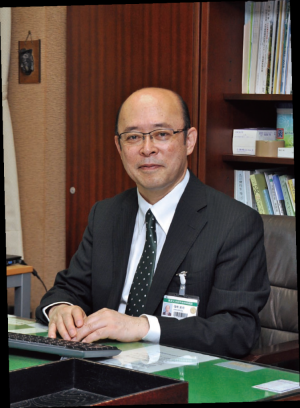Top > About Us > News Letter > Hoping to support the continuous development of the hospital with my “on-site point of view” that has been developed over 30 years
Hoping to support the continuous development of the hospital with my “on-site point of view” that has been developed over 30 years
New General Manager of Administration Office Eiji Shiozaki

All of the previous general managers of the Administration Office had great careers in the Japanese Ministry of Education, Culture, Sports, Science and Technology before being appointed to this position. Comparing myself with them, I was very humbled when I was appointed as the new general manager. However, I have 30-years of experience of being engaged in administrative affairs in various hospitals and the most recent 5-years of experience as the manager of the Office of Management Planning in the University of Tokyo Hospital. Through the experience, I believe that I can contribute to the hospital from a new direction that is different from those of the previous general managers. In addition, I believe that to support the director and hospital executives, my own objective is to determine how to make use of the “on-site point of view” that I have developed.
For the last 30 years, at the clinical sites of university hospitals, I have seen the great efforts of physicians who work hard and literally run around for doing medical practices and research activities in and outside of their university day and night even in holidays and of nurses and other medical staff members who devote themselves to supporting patients. I have also seen patients who visit the hospital as the “last bastion” that is held by hard-working healthcare professionals. It is meaningful and worthy to me as an administrator to provide intense support to the continuous development of the clinical site relying on their goodwill.
Currently in the medical field, functional differentiation of hospitals is in progress to cope with the “Year 2025 problem” associated with the aging population. We are not in an era in which a hospital can maintain stable management simply by having more patients. It is important to figure out which hospital can accept how many patients with which types of diseases, how equipment is updated, how the human resources of various professions are secured to accept these patients, and other matters. To provide information for the decision-making of hospital management, we need to run a management system including cost-accounting that is required to determine the above factors. This is our immediate task.
In nurturing administrative staff members, I encourage them to gain enough experience so that they can propose a solution for a request from a healthcare professional by saying “We can do it in this way”, instead of saying “We cannot do it.” If their proposal is appropriate, more will be expected of the staff member. If they can respond to these expectations, they can achieve their potential. I would like them to feel that such self-fulfillment through their work can enrich their lives.
In 2016, national universities, including our hospital, will be in the third 6-year phase of the medium-term plan. In the first phase, we repeated trials and errors after the University of Tokyo was converted into an independent administrative entity, and in the second phase, we faced and addressed challenges to solve problems. After these two phases, we are now going to enter the third phase that could be a turning point for the steady growth. It will be my pleasure if I can enhance the frameworks of finance, human resources, and governance that support hospital management and can contribute to managing the environment in which all staff members in this hospital can devote their time and efforts to healthcare development. Focusing on this direction, I will work as hard as possible to inherit and advance the previous general managers’ efforts.
